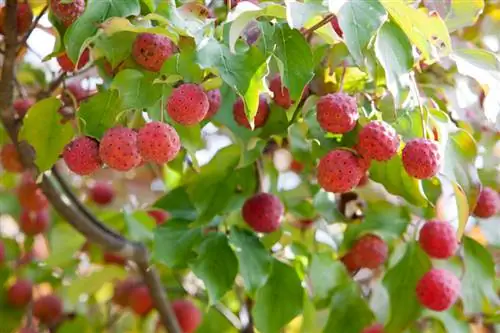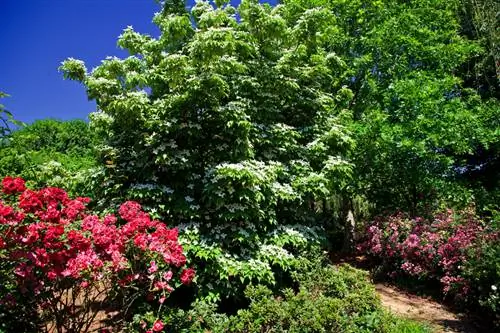- Author admin [email protected].
- Public 2024-01-10 23:11.
- Last modified 2025-01-23 11:20.
If the garden is still in deep hibernation, the Japanese dogwood announces the approaching spring with bright yellow flowers. After the ornamental tree gave way to other plants throughout the summer, a furious finale follows in autumn with wonderfully colored leaves and fiery red fruits. Do you still have questions about cultivating a Cornus officinalis? Then delve into professional answers here, straight from gardening practice.

How to care for the Japanese dogwood?
The Japanese dogwood (Cornus officinalis) is an ornamental tree that delights with bright yellow flowers in late winter. The plant thrives in normal, fresh, moist garden soil, prefers sunny to semi-shady locations and requires regular water supply until it is well rooted. In autumn it is fertilized with compost and horn shavings.
Planting Japanese dogwood correctly
Nursery stores offer the Japanese dogwood as a container plant with heights of 40 to 200 cm. This has the advantage that you can plant the ornamental tree in the ground all year round as long as it doesn't freeze. How to do it right:
- Place the potted root ball in water until no more air bubbles appear
- Dig a planting pit with twice to three times the volume of the root ball
- Add compost, horn shavings and, if necessary, some sand to the excavation
- Plant the potted shrub so that the ball of soil is flush with the garden floor
- Water generously and mulch with leaves, grass clippings or bark mulch
If it is a single-shoot young plant that is being trained into a tree, drive a support post into the planting hole. Connect the post and trunk with a wide binding material that does not cut into the young bark.
Care tips
Until a Japanese dogwood has become well rooted in the soil, regular water supply is the focus of care. In later years, normal rainfall will cover demand. Only in dry summers should you water the ornamental tree thoroughly once or twice a week by running the garden hose for 20-25 minutes. In autumn the plant gratefully accepts a portion of compost with horn shavings. In addition, dead branches are cut off at the base every 1 to 2 years to allow light to reach all regions of the shrub and crown. If necessary, cut the Cornus officinalis, which tolerates pruning, into shape immediately after flowering, although it should be noted that this measure will result in the loss of some of the fruit decoration.
Which location is suitable?
It is in the nature of things that a sunny location motivates the Japanese dogwood to bloom lavishly. In partially shaded locations, the late winter blooms are somewhat sparser. Thanks to the stable wooden structure, the chosen spot can be a little windy. A Cornus officinalis has no special requirements when it comes to soil conditions, as it thrives in any normal garden soil.read more
The correct planting distance
The Asian ornamental tree takes on an impressive volume under your loving care. As a shrub, a growth width of 300 cm is not uncommon, provided you allow it. A tree can easily reach a height of 7 meters if you don't put a stop to it with appropriate pruning measures. We therefore recommend a planting distance of 3-4 meters.
What soil does the plant need?
When it comes to soil conditions, a Japanese dogwood is undemanding. It is content with a place in normal, freshly moist to moderately dry soil. A high nutrient content is an advantage, supplemented by vital soil life with plenty of humus.
When is flowering time?
After a mild winter you can see the bright yellow flower umbels from a distance. With every step that brings you closer to a Japanese dogwood, the sweet scent hits your nose. By now you should be able to hear the busy hum of happy bees and bumblebees enjoying the early nectar buffet. The flower spectacle lasts until April.
Cut Japanese dogwood correctly
As an early bloomer, cut back a Cornus officinalis immediately after flowering if the tree exceeds the planned dimensions. Of course, pruning is not absolutely necessary because the harmonious growth habit develops on its own. However, you should not forego annual thinning during the leafless period. To prevent the shrub or crown from becoming bare from below, remove dead wood, diseased and stunted shoots and inward-facing branches.read more
Watering Japanese dogwood
The Asian flower beauty prefers even soil moisture, without fluctuations towards dryness or waterlogging. If the amount of rain does not cover the requirements, always water when the surface has dried out. A 5-6 cm thick layer of mulch makes a valuable contribution to maintaining sufficient soil moisture.
Fertilize Japanese dogwood properly
So that the Asian cornelian cherry has enough energy for the longed-for flowering in late winter, fertilize the tree in early autumn. Between the end of August and mid-September, work around 3 liters of compost superficially onto the root disk; ideally supplemented with horn shavings. Drizzle the organic material with comfrey manure. The potassium it contains naturally strengthens winter hardiness.
Wintering
Freshly planted, a Japanese dogwood does not yet have the robust frost hardiness of an adult specimen. We therefore recommend winter protection in the first year. Pile up leaves, compost and coniferous twigs on the root disk. The young branches are covered with a breathable fleece.
Propagate Japanese dogwood
In view of the rather expensive purchase of young trees, the uncomplicated propagation methods come in very handy. Choose from the following approaches:
- Cut non-flowering head cuttings in March and let them root in the pot
- Pull the sinker to the ground, cover the middle part with soil so that a root system forms
- Cut off cuttings in winter to plant them directly in the ground or in the pot for rooting
In contrast, sowing the seeds is time-consuming and delicate. Since these are cold germinators, a cold stimulus is required to awaken the mood to germinate. Last but not least, Japanese dogwoods propagated from seedlings take 5 years or more until the first flowers appear.
Is Japanese dogwood poisonous?
Although the fruits are suitable for consumption, a Japanese dogwood is not completely harmless. The leaves are covered with extremely fine hairs that can cause allergies if they come into contact with the skin. Therefore, wear long-sleeved clothing and gloves when carrying out all planting and care work.
Are the fruits edible?
You won't like the red fruits freshly picked from the tree. Rather, the bitter, sour taste tightens your palate. This shortcoming is eliminated when boiled into jam, jam, compote or syrup. Adding plenty of sugar transforms the fiery red berries into a refreshing fruit delight.read more






